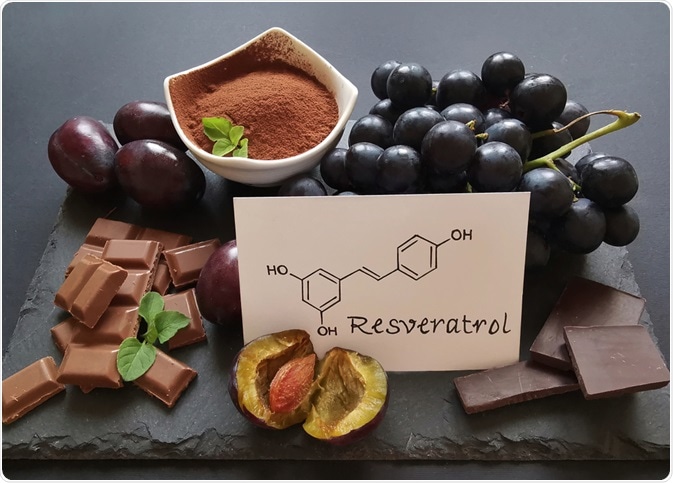With all of the attention surrounding resveratrol’s anti-aging effects, a central problem remains, namely, its poor bioavailability. Different approaches have been taken to solve this problem, but not all have been tested in human beings. This is another reason why resveratrol supplements are of doubtful value in the present scenario.

Image Credit: Danijela Maksimovic / Shutterstock.com
Bioavailability
Resveratrol bioavailability depends on the dose administered. Resveratrol is quickly cleared from the plasma through biological enzyme activity in the form of sulfates and glucuronides. The extent of activity of these metabolites is not well-known, though currently, it is believed that these substances are less active than the drug itself, in most settings.
Resveratrol is a small, non-polar molecule that is freely absorbed across the small intestine, mostly in combination with an adenosine triphosphate (ATP)-dependent binding cassette protein transporter.
Resveratrol administered in combination with food
Some evidence shows that resveratrol taken in combination with a standard breakfast increases the concentration in blood. However, a high-fat diet actually reduces the absorption of this substance.
Resveratrol in micronized form has a significantly increased absorption. One study showed a four-fold increase in plasma concentration, which is a doubling of the time to maximum plasma concentration. Taken together, this indicates a prolonged exposure and a nearly five-fold increase in the area under the curve (AUC), which corresponds to greater bioavailability, with the use of the 5 g dose in micronized form.
Resveratrol administration in combination with other plant polyphenols or other compounds found in red wine itself was thought to increase the absorption. While grape juice increases the time to clearance, it has not been shown to improve absorption of this compound as compared to red wine or other juices.
Resveratrol, in combination with other compounds that share the same enzymes, has the theoretical advantage of escaping the first-pass metabolism in the liver following intestinal absorption because the metabolizing enzymes would be saturated with the other polyphenols.
Piperine, which is the active compound found in pepper, increased the levels of resveratrol in the blood by a thousand times in rats and delayed the formation of one of its major metabolites. However, this has not been proven experimentally in humans, though the brain blood level of resveratrol was shown to increase.
The use of prodrugs has been attempted in rodents, though not in humans, using the resveratrol prodrug taRES, which showed an increase in bioavailability over the drug itself at comparable concentrations.
Altered formulations of resveratrol
Nanotechnology has brought promising results in rat trials, with the use of resveratrol nanoparticles in various formulations. Such formulations have shown increased stability and bioavailability of resveratrol, as well as a reduction in its metabolism that corresponded to a rise in its tissue availability.
Particularly within the liver, brain, and kidneys, resveratrol nanoparticles demonstrated improved tissue concentrations. This includes lipid-mounted, solid, or albumin-mounted nanoparticles. However, human study evidence is still lacking.
Sublingual or buccal capsules also have a higher absorption rate as compared to oral administration of resveratrol. Encapsulation is therefore a viable way to achieve stability and higher bioavailability. Grape skin extract and grape seed oil can be encapsulated to form a stable and spontaneous nanoemulsion, which has also been used as a delivery system.
Intravenous bolus doses not only achieved a higher plasma concentration as compared to oral administration of resveratrol but also produced acute changes in renal blood flow and other metabolic parameters, thereby indicating their promise in various clinical fields.
Resveratrol implants that release the drug over a long period of time were also found to extend the time of exposure to the drug. Hydrogels have also been studied as the vehicles for resveratrol absorption through the skin, with their viscosity determining the rate of permeation of the drug.
Resveratrol stents have been studied and show some potential utility in promoting the healing of injured arterial walls, as well as inhibiting stent closure after angioplasty and stenting. In contrast to other drug-eluting stents like Taxol or rapamycin-releasing devices, resveratrol does not inhibit healing and thus presents an advantage in preventing late thrombosis due to the persistence of unhealed intimal tissue in the coronary circulation.
Overall, the bioavailability of resveratrol in the blood is not limited by its plasma concentration. The amount of resveratrol delivered to various tissues is also important in measuring its absorption and tissue exposure.
References
Further Reading